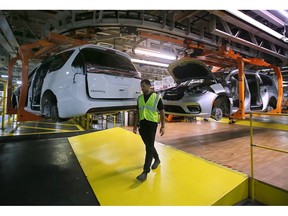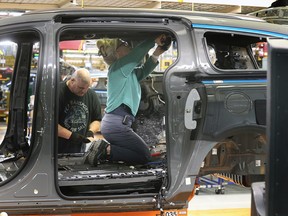Published Nov 20, 2023 • Last updated 14 hours ago • 5 minute read

Though the Detroit 3 automakers paid a significant price to gain labour peace in 2023, industry observers feel the companies’ improved wages and benefits packages make automotive jobs attractive once again.
Leading up to this year’s negotiations the automakers had seen job offers turned down; skilled trades positions unfilled; or worse: journeymen leaving for better-paying positions in other sectors.
THIS CONTENT IS RESERVED FOR SUBSCRIBERS ONLY
Subscribe now to read the latest news in your city and across Canada.
- Unlimited online access to articles from across Canada with one account.
- Get exclusive access to the Windsor Star ePaper, an electronic replica of the print edition that you can share, download and comment on.
- Enjoy insights and behind-the-scenes analysis from our award-winning journalists.
- Support local journalists and the next generation of journalists.
- Daily puzzles including the New York Times Crossword.
SUBSCRIBE TO UNLOCK MORE ARTICLES
Subscribe now to read the latest news in your city and across Canada.
- Unlimited online access to articles from across Canada with one account.
- Get exclusive access to the Windsor Star ePaper, an electronic replica of the print edition that you can share, download and comment on.
- Enjoy insights and behind-the-scenes analysis from our award-winning journalists.
- Support local journalists and the next generation of journalists.
- Daily puzzles including the New York Times Crossword.
REGISTER TO UNLOCK MORE ARTICLES
Create an account or sign in to continue with your reading experience.
- Access articles from across Canada with one account.
- Share your thoughts and join the conversation in the comments.
- Enjoy additional articles per month.
- Get email updates from your favourite authors.
Article content
Article content
“The companies encountered the problem of the low-wage model in recruitment and retention not working, that’s why they were willing to pay these wage increases,” said Jim Stanford, a Canadian economist and director of the Centre for Future Work.
“The exit threat is a problem for an industry that needs a thousand workers at the right place at the right time. The auto industry is very vulnerable to turnover.
“The new contracts will allow them to build a skilled workforce for the next generation. I think it’s a win-win for both sides.”
Unifor officials estimate the base wage, without overtime, of a production worker at top of the four-year salary grid will be $95,000 plus benefits at the end of the three-year contract. Stellantis workers in the U.S. ratified their new contract in voting over the weekend.

Workers will see total wage increases ranging from 20 to 25 per cent, depending on their job classification, with the cost-of-living allowance folded in.
“The big impact is people — young and highly qualified people — are going to want to work in the industry again,” said Brendan Sweeney, managing director of the Trillium Network for Advance Manufacturing.
Article content
“The wages and benefits are competitive now. Benefits attract people with families.
“People with families stay with their employer. This is going to help companies stabilize their workforces.”
Sweeney said it’s particularly important that many of the most significant gains really help younger workers.
Reduction of the wage grid to four years from eight will result in many newly hired workers getting wage increases of more than $20 per hour by the end of the deal.

Anyone hired after Nov. 7, 2016, will also now be part of a defined benefits pension plan rather than the existing defined contribution plan.
“That will be noticed not just by employees of the Detroit 3, but future employees and those who are not even a member of a union,” Sweeney said.
“It’s a real departure from the contracts of a decade ago. This could be really important for the vitality of the workforce of the three companies and the union.
“The union has demonstrated its value to younger and older workers.”
Automotive Parts Manufacturers Association president Flavio Volpe agreed labour is enjoying a moment right now. He said some of the key questions going into these complicated negotiations were around Unifor and how it would perform under new national president Lana Payne with workers’ expectations so high.
Article content
“They got the gains they were looking for and outside observers like me, who were watching to see if Unifor would continue to be a serious player in this space, saw they have serious, disciplined leadership there,” Volpe said.
“It’s not easy to do when you had the U.S talks going on at the same time, which were very public and cartoonish.”

Volpe said the “quiet, professional tone” Unifor took in the negotiations is a selling point for the Canadian industry.
He added the written product commitments the companies have made have filled in the blanks for automotive suppliers.
“Our membership was looking to see how committed the companies were to those announcements in places like Brampton and Windsor,” Volpe said.
“With Stellantis planning on going to three shifts at those plants, it tells us about the importance of those products to the company and how well they expect those vehicles to sell.”
Volpe said he doesn’t expect too much of a ripple effect from the contracts for automotive suppliers. He said wages and benefits had already started to rise significantly heading into the COVID pandemic.
Article content
“Eighty per cent-plus of the supply sector is non-unionized,” Volpe said. “We’ve all had to look at our compensation packages.
“To retain and recruit, we’ve had to be competitive in those compensation packages. Those who don’t, risk losing people to OEMs (original equipment manufacturers) now.”
University of Windsor associate professor of labour relations Rachel Aleks doesn’t expect the cost of the contracts to have much effect on companies’ investment decisions going forward.
She called the Unifor and UAW deals ‘mega-successes’ but, importantly, they kept the labour costs in both countries comparable.
“These were contracts the companies could clearly afford,” Aleks said.
“Labour is five per cent of the cost of building a car. It’s hard to sell to an informed audience that decisions will be made blaming this new contract, especially with executives earning massive amounts.”
In addition to wages and benefits, Aleks said the reduction of the salary grids in both countries and the elimination of a lower two-tier pay scale at some U.S. plants were key improvements.
Article content
“The UAW ending the two-tier system was important,” Aleks said. “That was a huge problem undermining solidarity internally for the union.”
Aleks expects the auto companies will focus on the tricky transition of integrating battery plants and retooled facilities for electric vehicle production now that they’ve achieved labour peace.
For the unions, Aleks said there’s a significant opportunity to raise the labour movement’s profile after successful negotiations. In particular, she feels the UAW used the negotiations to build a platform to launch an attempt to expand unionization in the U.S. to other automakers and sectors of the economy.
That won’t be an easy task with non-unionized automakers intent on keeping unions out of their plants.
Toyota moved quickly Wednesday to raise workers’ top wages to US$34.80 per hour in the U.S. effective Jan. 1. It’s the third raise this year for the company’s manufacturing, logistics and distribution centre employees.
Related Stories
-
Local auto sector had historic year of announcements in 2022
-

Ontario incentives, university's CHARGE Lab draw interest from companies at Detroit auto show
Article content
Unifor expects Toyota and Honda to also raise wages at its non-union manufacturing plants in Canada in light of the Detroit 3 settlements.
“I’d find it hard to be a non-union member reading about these deals and not at least think about organizing some form of a union at my workplace,” Aleks said.
“Rightly or wrongly, people associate unionization with the auto industry. It’s important for the labour movement broadly to have a grand victory in the industry it’s most associated with.”
Stanford, a former director of policy for Unifor, called the new contracts a rebalancing of the relationship between labour and the automakers more than a significant change.
He added the deals also herald the launch of an exciting era for the Canadian automotive industry.
“The combination of new contracts, previously announced investments and support through government polices around electric vehicles and battery plants, I think the Canadian industry is poised for a new generation of prosperity,” Stanford said.
“It’s exciting to see the footprint grow. It’s such a different mood than the industry experiences of the last couple of decades.”
Article content















